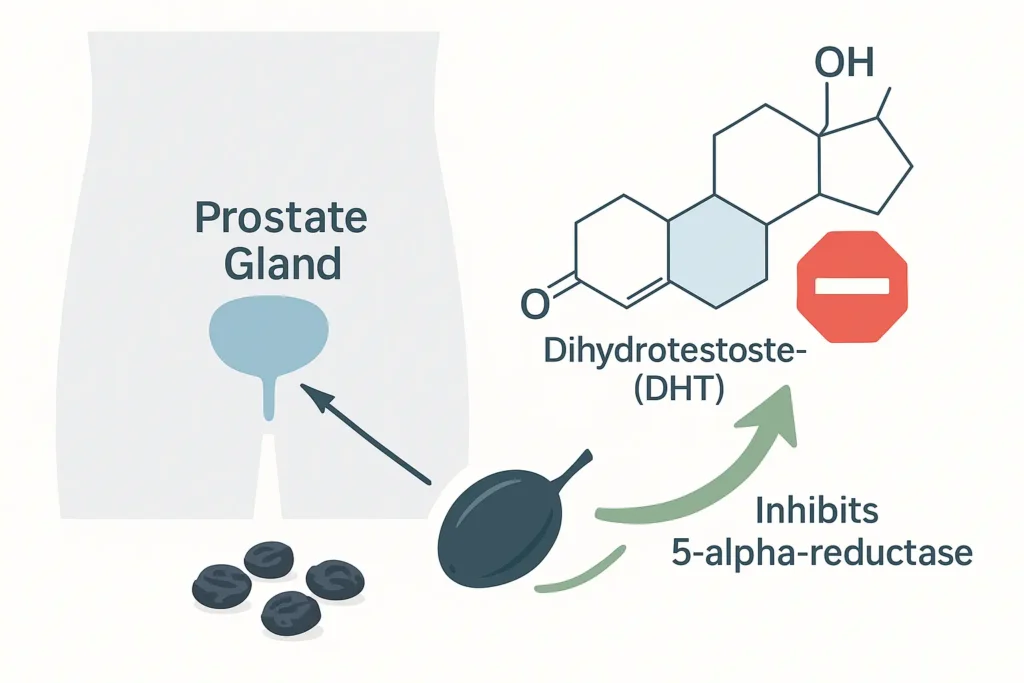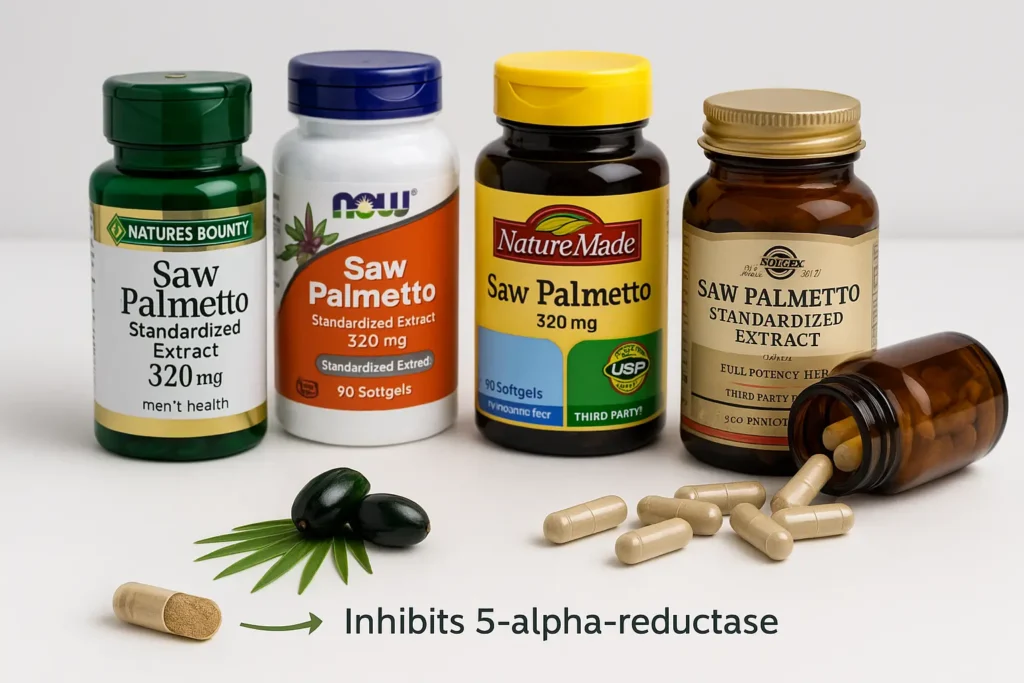Saw Palmetto, a plant steeped in a rich history of medicinal use, stands as a beacon in the world of natural health remedies, particularly for prostate health.
Overview of What Saw Palmetto Is Saw Palmetto, scientifically known as Serenoa repens, is a small palm tree native to the southeastern United States. Its hallmark is the dark berries it produces, which have been a cornerstone in herbal medicine. This plant’s extract, derived primarily from its berries, is celebrated for its therapeutic properties, especially in addressing issues related to the prostate gland in men.
Its Historical Use and Significance The use of Saw Palmetto dates back to the Native Americans of the Southeastern United States, who valued the berries for their nutritional and medicinal properties. They used Saw Palmetto to treat a variety of urinary and reproductive system problems. As European settlers arrived, they quickly adopted the use of these berries, integrating them into their own medicinal practices.
Over the years, Saw Palmetto gained prominence in the realm of herbal medicine. By the 20th century, it became particularly renowned for its potential benefits in treating benign prostatic hyperplasia (BPH), a common condition affecting the prostate gland. Its enduring use throughout history is a testament to the enduring belief in its healing properties.
Saw Palmetto and Prostate Health: The Core Connection
The intertwining of Saw Palmetto with prostate health is a narrative rich in both history and potential, offering a natural approach to addressing some of the most common prostate concerns.
Explaining the Link Between Saw Palmetto and Prostate Wellness Saw Palmetto has long been revered for its potential impact on prostate health, especially due to its unique active components. These components, including fatty acids and phytosterols, are thought to play a significant role in supporting prostate health. The primary way Saw Palmetto exerts its effect is believed to be through the inhibition of 5-alpha-reductase, an enzyme that converts testosterone to dihydrotestosterone (DHT). Elevated levels of DHT are associated with prostate enlargement and related issues.
Moreover, Saw Palmetto is known for its anti-inflammatory properties, which are crucial in maintaining a healthy prostate. Inflammation can be a key factor in various prostate issues, and managing it naturally can be a significant step towards overall prostate wellness.
Overview of Prostate Issues and Concerns The prostate, a small gland near the bladder in men, is prone to various problems, especially as men age. The most common issues include benign prostatic hyperplasia (BPH), which involves the enlargement of the prostate gland and can lead to urinary problems. Prostatitis, an inflammation of the prostate, is another common concern, causing discomfort and urinary symptoms. While the causes of these conditions are diverse, managing their symptoms and impact is a key concern for many.
Saw Palmetto has been widely studied for its potential in easing the symptoms associated with these conditions, offering a beacon of hope for those seeking natural management options.

Active Compounds in Saw Palmetto
The potency of Saw Palmetto in supporting prostate health lies hidden within its complex array of active compounds, each playing a pivotal role in its therapeutic properties.
Identification and Roles of Key Compounds Saw Palmetto berries are a treasure trove of bioactive compounds, including fatty acids, plant sterols, and flavonoids. Among these, fatty acids such as lauric acid, myristic acid, and oleic acid are predominant. These fatty acids are known for their anti-inflammatory properties, which are crucial in managing prostate health.
Plant sterols, particularly beta-sitosterol, are another key component of Saw Palmetto. Beta-sitosterol is thought to help in reducing inflammation within the prostate and aiding urinary flow. Additionally, the presence of flavonoids in Saw Palmetto contributes to its overall antioxidant properties, offering protection against cellular damage.
How These Compounds Affect Prostate Health The compounds in Saw Palmetto work synergistically to impact prostate health positively. The inhibition of the enzyme 5-alpha-reductase by these compounds is particularly significant. By preventing the conversion of testosterone to dihydrotestosterone (DHT), they help in reducing the risk of prostate enlargement, commonly seen in conditions like benign prostatic hyperplasia (BPH).
The anti-inflammatory action of the fatty acids and phytosterols in Saw Palmetto also plays a crucial role. This action can alleviate symptoms associated with prostatitis and BPH, such as urinary discomfort and the frequency of urination. Additionally, the overall health of the prostate is supported by the antioxidant effects of the flavonoids present, safeguarding the cells from oxidative stress and damage.
Saw Palmetto in Traditional and Modern Medicine
Saw Palmetto, a beacon of natural healing, has bridged the divide between traditional herbal practices and modern healthcare, offering a continuum of benefits across time.
Historical Uses of Saw Palmetto in Herbal Medicine The journey of Saw Palmetto in traditional medicine is as rich and varied as the cultures that have embraced it. Historically, the Native Americans were the first to uncover the healing prowess of this small palm, particularly its berries. They used it to treat a variety of urinary and reproductive issues. It was also a staple in their diet, valued for its nutritional properties.
As the knowledge of Saw Palmetto spread, it found a place in various forms of traditional medicine. In the 19th and early 20th centuries, it was commonly used in Western herbal medicine for its therapeutic effects on the urinary tract and, specifically, the prostate gland. It was revered for its ability to ease symptoms associated with prostate enlargement and other urinary difficulties.
Its Current Status in Modern Healthcare In modern healthcare, Saw Palmetto has transcended its traditional roots, emerging as a popular supplement, particularly among men seeking natural support for prostate health. Its use is widely supported by a growing body of scientific research, particularly in the treatment of benign prostatic hyperplasia (BPH). While it is not a prescribed medication, its popularity in over-the-counter supplements has surged, with many users reporting significant relief from BPH symptoms.
Saw Palmetto’s role in modern medicine continues to evolve, with ongoing research exploring its full potential and mechanism of action. It represents a harmonious blend of traditional wisdom and modern science, making it a subject of interest for both herbalists and medical practitioners.

Benefits of Saw Palmetto for Prostate Health
Saw Palmetto has garnered acclaim in the realm of natural remedies, particularly for its profound impact on prostate health, backed by scientific research and empirical evidence.
Detailed Exploration of Benefits The benefits of Saw Palmetto for prostate health are multifaceted. Its primary acclaim stems from its efficacy in managing symptoms of benign prostatic hyperplasia (BPH), a common condition characterized by the enlargement of the prostate gland. Men with BPH often experience urinary problems, and Saw Palmetto has been found to help in reducing these symptoms, including improving urinary flow and decreasing nighttime urination.
Another significant benefit of Saw Palmetto is its anti-inflammatory properties, which are crucial in alleviating discomfort associated with prostatitis, an inflammation of the prostate gland. By reducing inflammation, Saw Palmetto can help ease pain and urinary symptoms linked to this condition.
Scientific Studies and Evidence Supporting Its Use Numerous studies have explored the effects of Saw Palmetto on prostate health, with many indicating positive results. Research has shown that Saw Palmetto can effectively reduce the symptoms of BPH to a degree comparable to some pharmaceutical treatments, but with fewer side effects. This is attributed to its action in inhibiting the conversion of testosterone to dihydrotestosterone (DHT), a key factor in prostate enlargement.
Additionally, several clinical trials have highlighted its potential in reducing the inflammation associated with prostatitis. Its safety profile, coupled with its effectiveness, makes it a popular choice for those seeking natural management of prostate issues.
Saw Palmetto and BPH (Benign Prostatic Hyperplasia)
In the realm of natural remedies, Saw Palmetto emerges as a beacon of hope for those grappling with Benign Prostatic Hyperplasia (BPH), offering a gentler yet effective approach to prostate care.
How Saw Palmetto Impacts BPH Benign Prostatic Hyperplasia, commonly known as prostate gland enlargement, is a frequent condition affecting older men. Saw Palmetto’s role in managing BPH symptoms has gained considerable attention due to its potential to mitigate these symptoms without the harsh side effects often associated with conventional treatments.
The primary way Saw Palmetto assists in BPH management is through its action on the enzyme 5-alpha-reductase. By inhibiting this enzyme, Saw Palmetto helps reduce the conversion of testosterone into dihydrotestosterone (DHT), a hormone that contributes to prostate growth. This action can lead to a reduction in urinary symptoms associated with BPH, such as frequent urination, difficulty in starting urination, and weak urine stream.
Comparisons with Conventional Treatments Conventional treatments for BPH typically involve medications like alpha-blockers and 5-alpha-reductase inhibitors, or in severe cases, surgical interventions. While effective, these treatments can have significant side effects, including sexual dysfunction, dizziness, and gastrointestinal issues.
Saw Palmetto offers a more natural alternative, with a lower risk of severe side effects. Studies comparing Saw Palmetto with standard BPH medications have shown that while it may not be as potent as some pharmaceuticals, its side effect profile is much milder, making it a preferred option for many seeking a more natural approach.
It’s important to note, however, that Saw Palmetto is not a cure for BPH but rather a way to manage its symptoms. Men with BPH should consult with healthcare providers to determine the best treatment plan, considering both conventional and alternative options.
Saw Palmetto for Prostatitis
Saw Palmetto, a natural ally in the realm of men’s health, shows promise in offering relief for those suffering from prostatitis, a condition that can significantly impact quality of life.
Understanding Prostatitis Prostatitis refers to the inflammation of the prostate gland, often resulting in discomfort, urinary problems, and sometimes pain. This condition can be acute or chronic and may be caused by a variety of factors, including bacterial infection. The symptoms, ranging from pain during urination to lower back discomfort, can disrupt daily life and cause significant distress.
How Saw Palmetto Can Be Beneficial Saw Palmetto is increasingly being recognized for its potential benefits in managing prostatitis, particularly chronic nonbacterial prostatitis, which is the most common form of the condition and notoriously difficult to treat.
The anti-inflammatory properties of Saw Palmetto play a crucial role here. By reducing inflammation in the prostate, Saw Palmetto can help alleviate the discomfort and pain associated with prostatitis. Additionally, its ability to inhibit the conversion of testosterone to dihydrotestosterone (DHT) may also contribute to reducing the swelling of the prostate, thereby easing symptoms.
Furthermore, Saw Palmetto’s potential benefits in enhancing urinary flow and reducing nighttime urination can significantly improve the life quality of those with prostatitis. While it’s not a cure, Saw Palmetto offers a natural option for symptom management, often with fewer side effects compared to conventional medications.
It’s important for individuals with prostatitis to consult with healthcare professionals before starting any new treatment, including natural supplements like Saw Palmetto, to ensure it’s appropriate for their specific condition.

Usage Guidelines: Dosage and Administration
Navigating the use of Saw Palmetto, especially in the context of dosage and administration, is crucial for harnessing its full potential in supporting prostate health.
Recommended Dosages The recommended dosage of Saw Palmetto can vary depending on the form and preparation of the supplement. Generally, for prostate health, the typical dosage ranges from 160 to 320 mg per day. These dosages are often taken in divided doses, twice a day.
It’s important to note that Saw Palmetto supplements come in various forms, including capsules, tablets, soft gels, and liquid extracts. The concentration of active ingredients can differ between products, so it’s essential to follow the dosage instructions provided by the manufacturer or a healthcare professional.
For conditions like benign prostatic hyperplasia (BPH) or prostatitis, the higher end of the dosage range is often recommended. However, starting with a lower dose and gradually increasing it allows you to monitor your body’s response.
Tips for Effective Use
- Consistency is Key: Regular and consistent use of Saw Palmetto is important for seeing benefits. It may take several weeks or even months to notice improvements.
- With Meals: Taking Saw Palmetto with meals can help improve its absorption and reduce any digestive side effects.
- Quality Matters: Opt for high-quality Saw Palmetto supplements from reputable manufacturers to ensure the efficacy and safety of the product.
- Monitor Your Body: Pay attention to how your body responds to Saw Palmetto, and consult a healthcare provider if you experience any adverse effects.
- Avoid Overuse: Stick to the recommended dosages. Higher doses do not necessarily translate to more significant benefits and can increase the risk of side effects.
Potential Side Effects and Interactions
While Saw Palmetto is celebrated for its benefits, particularly in prostate health, understanding its potential side effects and interactions with medications is essential for safe and informed use.
Common Side Effects Saw Palmetto is generally well-tolerated, but like any supplement, it can cause side effects in some individuals. The most common side effects include mild digestive upset, such as nausea or stomach discomfort. Some men may also experience headaches or dizziness. In rare cases, it can cause reduced libido or erectile dysfunction.
While these side effects are typically not severe, it’s important to listen to your body and consult a healthcare provider if you experience any discomfort or unusual symptoms.
Potential Interactions with Medications One of the key considerations when using Saw Palmetto is its potential interaction with certain medications. Saw Palmetto may interact with blood thinners like warfarin or aspirin, potentially increasing the risk of bleeding. It might also interact with hormonal therapies, including birth control pills or hormone replacement therapy, as well as medications used in hormone-sensitive conditions like prostate cancer.
Additionally, since Saw Palmetto can affect hormone levels, it’s important to exercise caution when combining it with other supplements or medications that have similar effects.
If you are on any medication, especially for conditions related to the heart, blood, or hormones, it’s crucial to consult with a healthcare provider before starting Saw Palmetto. This ensures that your supplement regimen is safe and complements your overall health plan.
Comparing Saw Palmetto with Other Prostate Health Supplements
In the pursuit of optimal prostate health, understanding the landscape of available supplements is key. Saw Palmetto, a standout in this realm, is often compared with other natural remedies.
Overview of Other Supplements Apart from Saw Palmetto, several other supplements are touted for their benefits in promoting prostate health. Some of these include:
- Beta-Sitosterol: Found in various plants, it’s known for improving urinary symptoms associated with BPH and boosting overall urinary function.
- Pygeum: Derived from the bark of the African plum tree, Pygeum is traditionally used for urinary problems and has shown promise in managing BPH symptoms.
- Stinging Nettle: Often used in combination with other supplements, it’s believed to help reduce symptoms of BPH.
- Pumpkin Seeds: Rich in zinc and fatty acids, pumpkin seeds are thought to support prostate health and help manage BPH symptoms.
- Lycopene: An antioxidant found in tomatoes, it’s studied for its potential in reducing the risk of prostate cancer and managing BPH symptoms.
Comparative Analysis When compared to other supplements, Saw Palmetto stands out for its dual action in inhibiting the enzyme 5-alpha-reductase and reducing inflammation, making it particularly effective for BPH symptoms. While beta-sitosterol also aids in urinary symptoms, Saw Palmetto’s broader anti-inflammatory properties give it an edge in overall prostate wellness.
Pygeum and Stinging Nettle are often used as adjuncts to Saw Palmetto, enhancing its effects, especially in urinary function. Pumpkin Seeds and Lycopene, though beneficial, tend to have a more preventive role in prostate health rather than therapeutic.
Each of these supplements has its unique properties and benefits. However, Saw Palmetto’s widespread use and the volume of research supporting its effectiveness make it a popular choice for many men dealing with prostate issues.
Sourcing and Choosing Quality Saw Palmetto Supplements
In the quest for enhanced prostate health, selecting the right Saw Palmetto supplement is crucial. The effectiveness of Saw Palmetto largely depends on its quality and purity.
Tips on Selecting the Best Products
- Look for Standardized Extracts: Opt for supplements that contain standardized extracts of Saw Palmetto. Standardization ensures that the product contains a consistent and guaranteed percentage of the active compounds.
- Check the Dosage: Verify that the dosage of Saw Palmetto in the supplement aligns with the recommended range for prostate health, typically between 160 to 320 mg.
- Examine the Supplement Facts: Read the label for additional ingredients. A good Saw Palmetto supplement should have minimal fillers, binders, or artificial additives.
- Choose a Reputable Brand: Research brands for their credibility and quality assurance practices. Brands that are transparent about their sourcing and manufacturing processes are often more reliable.
- Certifications and Third-Party Testing: Look for products that have been third-party tested for purity and potency. Certifications from recognized bodies can also be a sign of quality.
- Form of the Supplement: Saw Palmetto comes in various forms, such as capsules, soft gels, and liquid extracts. Choose a form that aligns with your preference and absorption.
Importance of Quality and Purity The quality and purity of Saw Palmetto supplements are paramount. High-quality, pure supplements are more likely to provide the desired health benefits and reduce the risk of contaminants or unwanted side effects. Impure products, on the other hand, may not only be ineffective but could also pose health risks. Investing in a quality supplement ensures that you are getting the full therapeutic potential of Saw Palmetto.
Conclusion
As we draw our exploration of Saw Palmetto and its profound impact on prostate health to a close, it’s clear that this natural remedy holds a special place in the world of herbal supplements.
Saw Palmetto’s journey from a traditional herbal remedy to a widely recognized supplement for prostate wellness is a testament to the power of nature in supporting health. Its ability to offer relief in conditions like benign prostatic hyperplasia (BPH) and prostatitis, while balancing efficacy with a gentler side effect profile compared to conventional treatments, makes it a beacon of hope for many.
The importance of choosing the right Saw Palmetto supplement cannot be overstated – quality and purity are key to harnessing its full potential. As we’ve navigated through the various aspects of Saw Palmetto, from its historical roots to its modern applications, it becomes evident that this humble plant is more than just a supplement; it’s a symbol of holistic well-being.
As you consider integrating Saw Palmetto into your health regimen, remember that this journey is as much about nurturing your body’s natural balance as it is about addressing specific health concerns. We encourage you to discuss with healthcare professionals, embrace a holistic approach to health, and consider Saw Palmetto as a natural ally in your pursuit of wellness.
In closing, let the story of Saw Palmetto inspire you to explore the rich tapestry of natural remedies available to us. May your journey towards health and well-being be as enriching as it is enlightening.
Bonus
Combining Saw Palmetto with certain foods and nutrients can enhance its benefits, especially in supporting prostate health. Here are some effective combinations that resonate with the goal of holistic wellness:
- Tomatoes: Rich in lycopene, a powerful antioxidant, tomatoes can complement the anti-inflammatory properties of Saw Palmetto. Lycopene is particularly beneficial for prostate health, and combining it with Saw Palmetto can create a synergistic effect.
- Green Tea: Known for its antioxidant properties, green tea can work in harmony with Saw Palmetto. The catechins in green tea are believed to support urinary health and may help in managing symptoms associated with prostate enlargement.
- Pumpkin Seeds: These are a natural source of zinc, a mineral vital for prostate health. Pairing pumpkin seeds with Saw Palmetto can boost the overall nutritional support for the prostate.
- Omega-3 Rich Foods: Foods high in Omega-3 fatty acids, like salmon and flaxseeds, can enhance the anti-inflammatory effects of Saw Palmetto. Omega-3s are known to support overall health and can be particularly beneficial for reducing inflammation in the prostate.
- Cruciferous Vegetables: Vegetables like broccoli and Brussels sprouts contain sulforaphane and are known for their cancer-fighting properties. Including them in a diet with Saw Palmetto can bolster the body’s defenses against prostate issues.
- Berries: Rich in antioxidants, berries like blueberries and raspberries can support the antioxidant effects of Saw Palmetto, helping to protect the body from oxidative stress and maintain overall health.
- Whole Grains: Integrating whole grains into your diet can support digestive health, which is vital for overall wellness. Their fiber content complements Saw Palmetto’s benefits for the prostate.
- Turmeric: Known for its curcumin content, turmeric is a potent anti-inflammatory spice. When combined with Saw Palmetto, it can enhance the reduction of inflammation, especially beneficial for prostate health.
These combinations are not just about amplifying the benefits of Saw Palmetto; they are about embracing a lifestyle that cherishes and nurtures the body in its entirety. Remember, a holistic approach to health is not just about what you take as a supplement, but also about the food choices you make every day.
Resources
- National Center for Complementary and Integrative Health (NCCIH) – Offers comprehensive information on Saw Palmetto, including research, potential benefits, and safety considerations. Visit NCCIH
- Mayo Clinic’s Overview of Saw Palmetto – Provides a detailed look at Saw Palmetto, its uses, and its effectiveness, with insights from one of the leading healthcare organizations. Explore Mayo Clinic
- WebMD on Saw Palmetto – Features an overview of Saw Palmetto, including user reviews, side effects, interactions, and dosage. Visit WebMD
- Healthline’s Guide to Saw Palmetto – Offers an easy-to-understand guide on Saw Palmetto, its benefits, side effects, and more. Check out Healthline
- Urology Care Foundation’s Resources on Prostate Health – Provides a wealth of information on prostate health, including the role of supplements like Saw Palmetto. Visit Urology Care Foundation


0 thoughts on “Saw Palmetto Unveiled: A big Solution for Optimal Prostate Health”